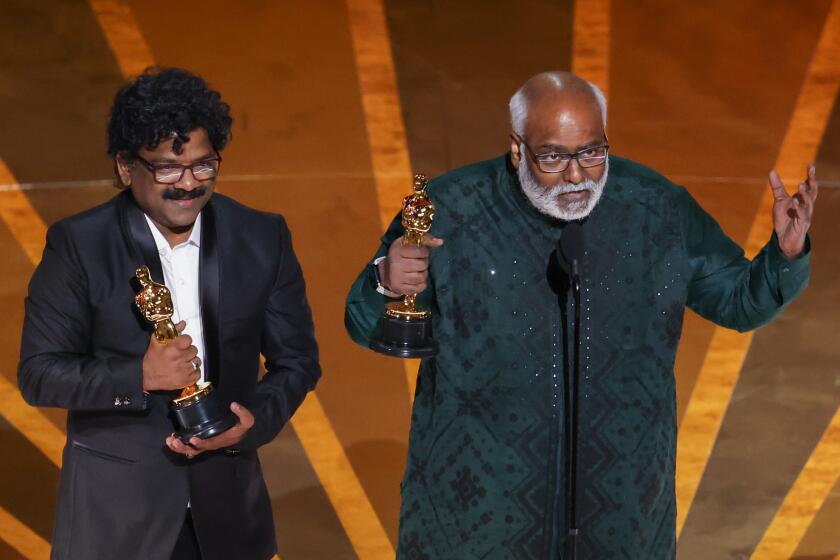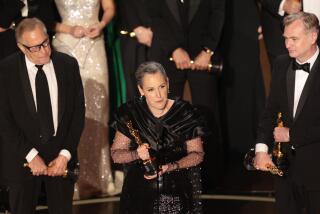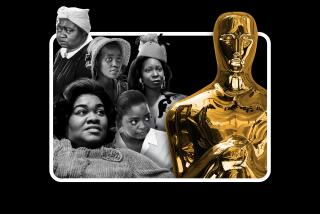‘RRR’s’ ‘Naatu Naatu’ made Oscars history. But South Asian dancers feel betrayed
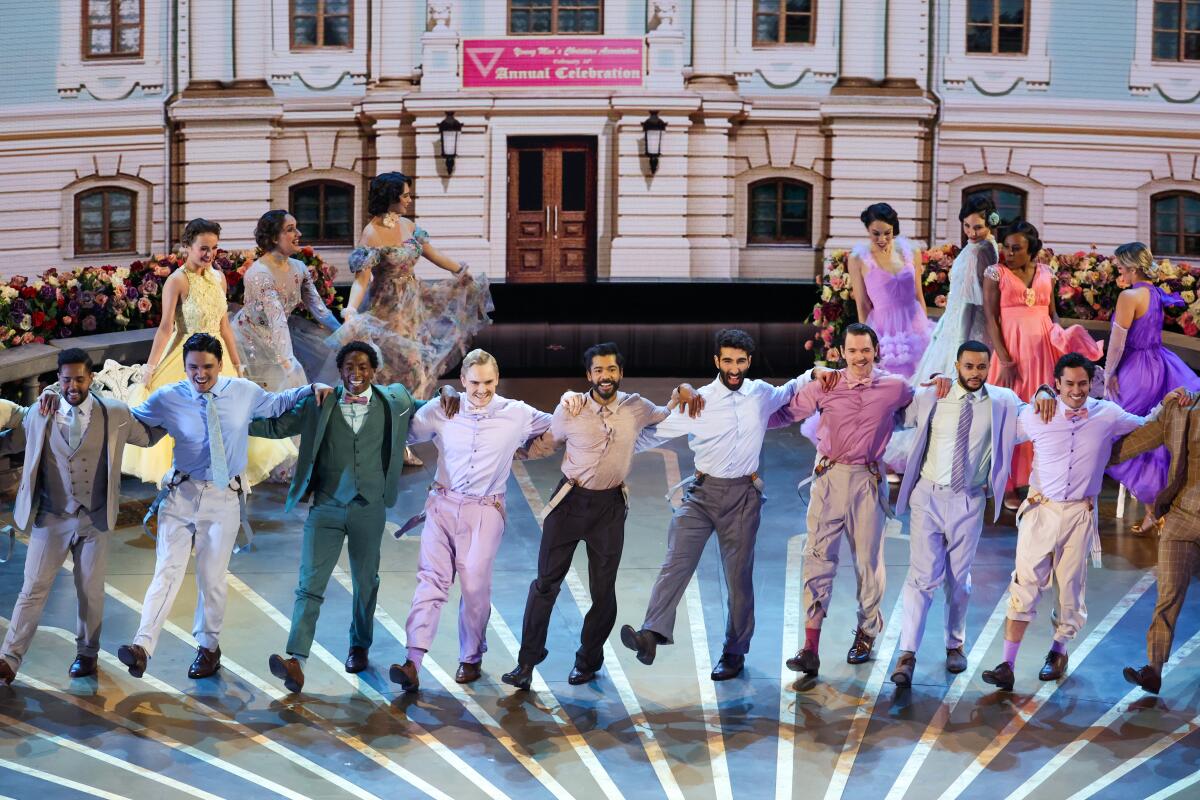
- Share via
After a milestone night for Asian and Asian American inclusion at the 95th Academy Awards, one community is still feeling the sting of being left out.
Sunday’s performance of the viral heel-tapping hit “Naatu Naatu,” which became the first tune from an Indian film to win the Oscar for original song, was meant to be a celebration of Telugu-language blockbuster “RRR’s” unlikely road to the Oscars. Instead, it left many in the South Asian community disappointed and outraged for failing to showcase any dancers of Indian descent onstage.
In the corresponding scene in the film, director S.S. Rajamouli, composer M.M. Keeravani, lyricist Chandrabose, choreographer Prem Rakshith and stars N.T. Rama Rao Jr. and Ram Charan construct a paean to South Indian dance, with freedom fighters Bheem (NTR Jr.) and Rama (Charan) facing off in competition against Caucasian British men and women. Breaking into dizzying hook steps, the heroes defeat their elitist rivals with moves rooted in Indian folk dance.
South Asian dancers and choreographers who spoke to The Times say that message was diluted on the Dolby Theatre stage, where U.S. choreographers Napoleon and Tabitha D’umo, known for their work on reality competition series “So You Think You Can Dance,” adapted Rakshith’s original choreography for the telecast. Principal dancers Billy Mustapha and Jason Glover were styled as stand-ins for NTR Jr. and Charan’s characters, lip-synching to the song as “Naatu Naatu” singers Rahul Sipligunj and Kaala Bhairava performed it. In a nod to the film’s global popularity, nonwhite dancers were cast in some ensemble roles as “British” characters.
The infectious number from action blockbuster ‘RRR’ made it the first Indian film to be nominated in any category outside international film.
Critics of the number cited the casting of the two non-South Asian lead dancers as an example of the challenges that face South Asian performers trying to gain a foothold in the business. (Mustapha, who is Lebanese Canadian, spoke to Global News on Monday about his reservations about the casting; a representative for Glover referred The Times to the motion picture academy, which declined to clarify the performer’s ethnic identity.)
Backlash snowballed in the days following the Oscars as South Asian creatives raised the issue on social media, amplified by #OscarsSoWhite creator April Reign: “The Academy just can’t help themselves,” Reign tweeted, sharing an Oscars night report by IndieWire’s Proma Khosla and a viral TikTok critique by Maheetha Bharadwaj that has been viewed more than 399,000 times. “It would’ve been SO easy to highlight South Asian choreographers and dancers for this televised performance. They chose not to. The more things change, the more they stay the same.”
The truth of the matter is, there are Indian dancers out there. It’s just that the effort wasn’t made.
— Veteran choreographer Nakul Dev Mahajan
Reign’s suggestion that the onus fell on the academy and Oscars producers rather than the “Naatu Naatu” dancers themselves was echoed by those who work in the industry.
“It’s hard to say no to something like this. But I think it lies in the leaders of our community, and they need to do better so that they set the standard. South Asian dancers work hard to be proficient in their styles and uphold their culture and they’re so enthusiastic about it,” said Chase Constantino, an L.A.-based Indian Canadian choreographer, dancer and actor.
“The academy let a demographic down,” said Nakul Dev Mahajan, a dance industry veteran who served as a choreographer for “So You Think You Can Dance” for 13 seasons and even choreographed then-competitor Glover in a Bollywood-inspired number on the show. “The truth of the matter is, there are Indian dancers out there. It’s just that the effort wasn’t made.”
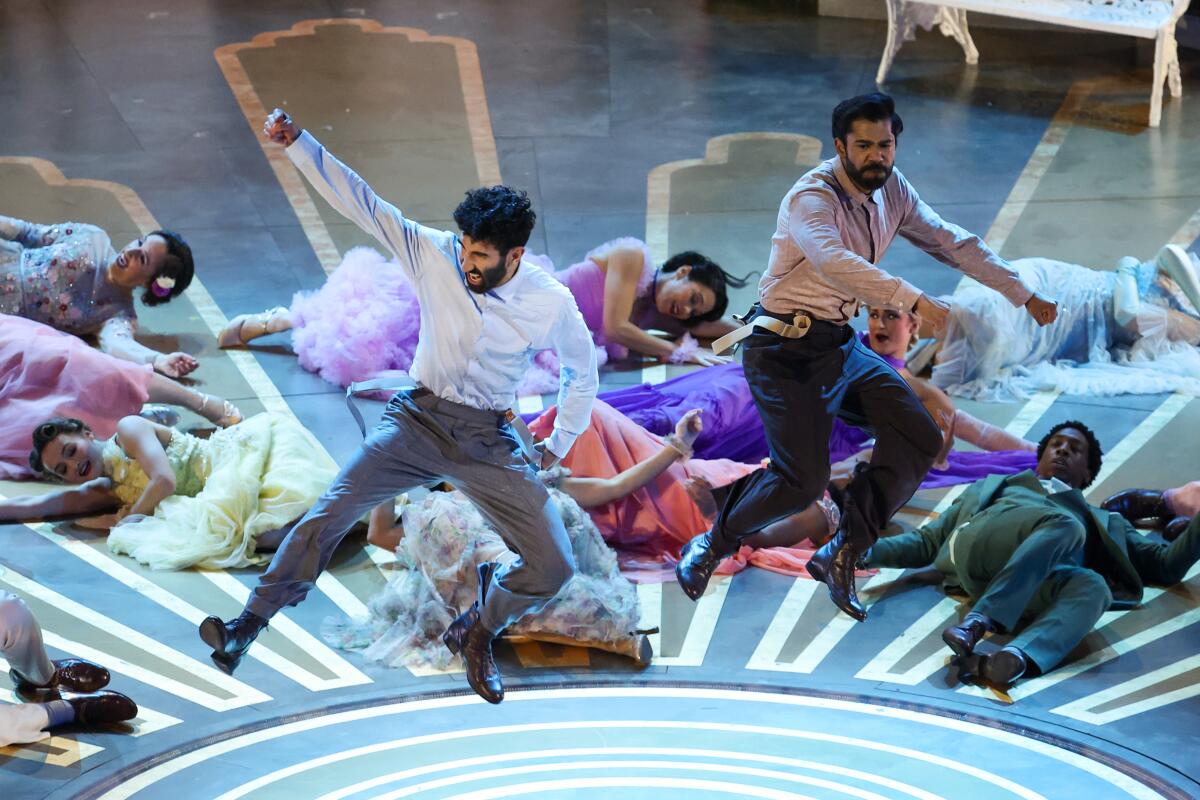
In a piece published Tuesday by the academy’s in-house magazine, A.Frame, Oscars producer Raj Kapoor explained the casting process.
“Global audiences fell in love with ‘Naatu Naatu’ and were dancing in theaters around the world, so we wanted to be open to any ethnicity to help honor the global impact of this song, and to celebrate that universal, unifying power of music and dancing,” he said. Kapoor noted that the piece was originally envisioned for NTR Jr. and Charan to dance in before the actors declined due to time constraints.
“Knowing that the two leads [of ‘RRR’] were unable to be involved, we worked in collaboration with Prem, our team in India, and our team in the U.S. to find two lead characters who captured the infectious energy of the characters in the film and their over-the-top energetic dance skills,” he told A.Frame.
Through a film academy representative, Kapoor declined to be interviewed, and the D’umos, who go by the moniker Nappytabs, were not made available for comment. But a source close to the production told The Times more effort was made than in previous telecasts to involve the original film creatives in the name of authenticity, including the “RRR” stars, PR team, producers and composer M.M. Keeravani, who won the Oscar on Sunday with Chandrabose.
Rakshith, who is based in India, could not be reached for comment. However, a source close to the film says that in part due to visa issues, the “Naatu Naatu” choreographer sent instructional videos to the U.S. choreographers and dancers but was not involved in either the selection of Nappytabs as choreographers or the casting of dancers, and did not see the performers or performance before arriving in Los Angeles for dress rehearsals.
The motion picture academy declined to comment.

The anger from South Asian creatives runs deeper than on-stage representation, though several noted with irony that hiring an ensemble to represent global diversity undercuts the original number’s anti-colonial message. The process, they say, also underscores creative shortcuts that can lead to exclusion.
For instance, the South Indian style of folk dance performed with percussion in “Naatu Naatu,” known as Kuthu, might take years of training to perfect, not the 18 hours of rehearsal that performers reportedly had to learn the dance. Yet such training is often dismissed as irrelevant in the industry.
“[Many dancers] have struggled with getting cast for big opportunities, because they don’t have the ‘right’ training. They don’t have the ‘right” experience,” said Meghna Chakraborty, a producer and dancer based in Los Angeles. “They’re not represented by agencies in the traditional way. They’re not a part of unions yet. The styles that we’ve trained in are not considered as legitimate as the Western dance styles. It’s just super disheartening.”
With “Naatu Naatu,” “RRR” is the first Indian film to be nominated for and win the original song Oscar. Danny Boyle’s “Slumdog Millionaire” had two nominations in the category for “O Saya” and “Jai Ho,” the latter of which won in 2009; both were performed by composer A.R. Rahman on that year’s telecast.
“Opportunities in terms of the scale and magnitude such as the Oscars or anything of that nature happen once in a blue moon,” said New York-based Rohit Gijare, an Indian American dancer and choreographer. “A lot of the time there hasn’t been work that we can audition for that is meant specifically for us, or that we identify with exactly.”
“It especially hurts when for a dance style that’s an Indian dance that’s Indian influenced and rooted in Indian culture,” said Chakraborty. “Even for that you think we’re not good enough?”
Joya Kazi, a dancer and choreographer of South Asian descent who has her own dance production company, posted on Instagram that her agents submitted her for the Oscars opportunity. She was told that “the choreographers want to work with dancers they already know.” The D’umos ended up hiring several dancers who were also alumni of “So You Think You Can Dance.”
“How are we going to ever expand the opportunities if people come to us and say, ‘Oh, you don’t have enough experience’? It’s because when the opportunity is there, you guys are not allowing us to step in,” Kazi said to The Times.
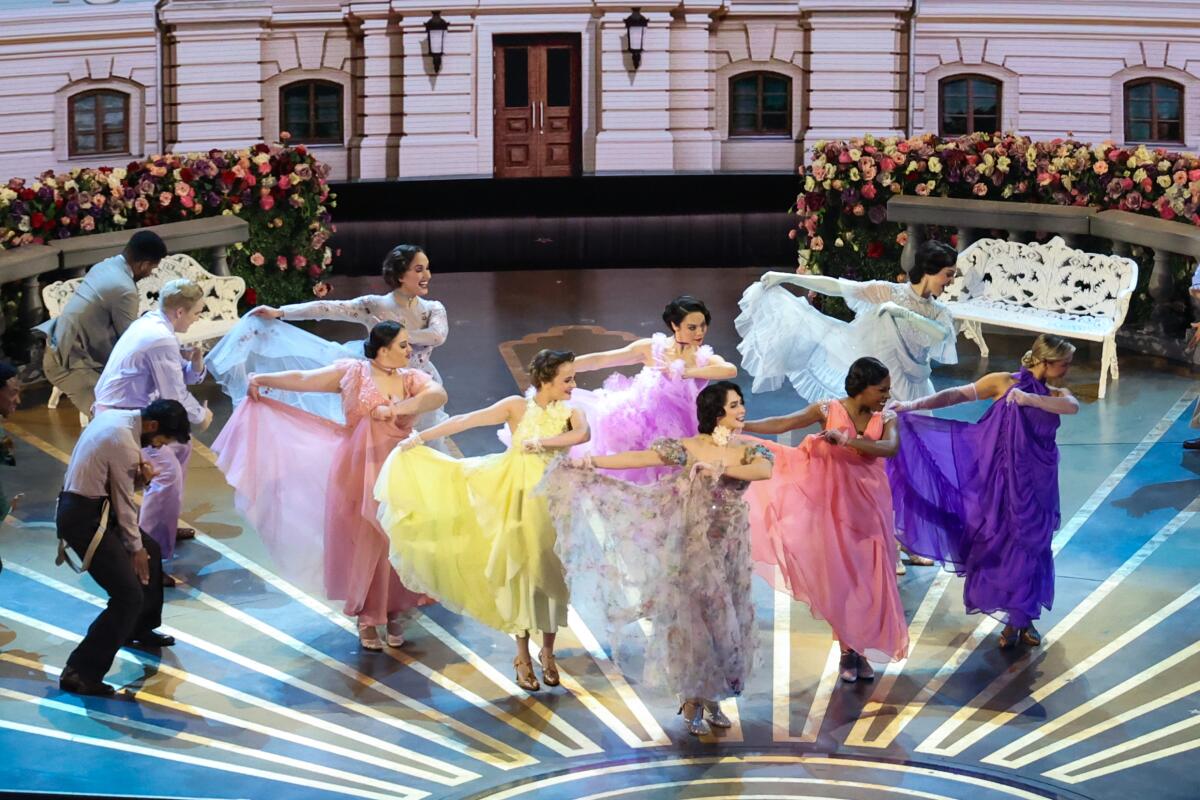
When Reshma Gajjar landed a featured dancing role in 2017 best picture nominee “La La Land,” “I knew my brown body normalized in a Hollywood musical was changing that narrative for younger generations,” she said. “It opened the door to career opportunities as an actor and a multihyphenate.”
The South Asian American actor and dancer, who performed at the 2009 Academy Awards, knew the creative team behind the “Naatu Naatu” Oscars number and was asked to audition. She sent in a self-tape, following the instructional video made by Rakshith’s team, and was hired, but a scheduling conflict led her to turn the job down.
“I didn’t realize that when I wasn’t available to do the performance, it would erase any and all South Asian representation on the stage,” said Gajjar.
Little of the Oscars number was known until American dancer Lauren Gottlieb, who works in the Hindi film industry, posted rehearsal footage of dancers in a now-deleted Instagram video days before the show. Despite her experience, Gottlieb incorrectly referred to “RRR” as a “Bollywood” rather than “Tollywood” film, as the Telugu-language industry is known, drawing ire on social media. (In a follow-up post late Wednesday, Gottlieb acknowledged the casting controversy: “I’ve heard and empathise with what people are saying about casting,” she wrote. “The conversation being had is important. Although I’m not a part of casting, I will be more vigilant and speak up.”)
Achinta S. McDaniel had questions after watching Gottlieb’s initial video. An Indian American choreographer, performer and professor at the USC Glorya Kaufman School of Dance with two decades of industry experience, McDaniel wondered: Where are the South Asian voices in the room?
“There were no South Asians in sight, much less a South Indian Telugu-speaking person,” she said by phone Wednesday.
McDaniel, who shares representation at dance agency MSA with Nappytabs, had been submitted as a choreographer weeks prior to the Oscars telecast. Hiring an assistant or associate choreographer of South Asian descent with training in Indian dance should have been the “bare minimum” on the part of Nappytabs and Academy producers, she said.
“It is their responsibility to leverage their seat at the table and say, ‘This is not our movement dialect, this is not who we are, there is a history of erasing South Asians and people of color in this industry, and we are not equipped to move forward,’” said McDaniel.
To gloss over the “Naatu Naatu” omission and instead celebrate Sunday’s performance as a win for multicultural diversity and inclusion is a “damaging and dangerous” act of erasure that renders South Asian talent invisible, said McDaniel, who says she has asked to meet with Nappytabs to help them and the industry avoid future missteps.
“It can actually be positive change that comes from this,” she said. “They can become allies yet if they can apologize and move forward with more cultural literacy.”
More to Read
From the Oscars to the Emmys.
Get the Envelope newsletter for exclusive awards season coverage, behind-the-scenes stories from the Envelope podcast and columnist Glenn Whipp’s must-read analysis.
You may occasionally receive promotional content from the Los Angeles Times.
